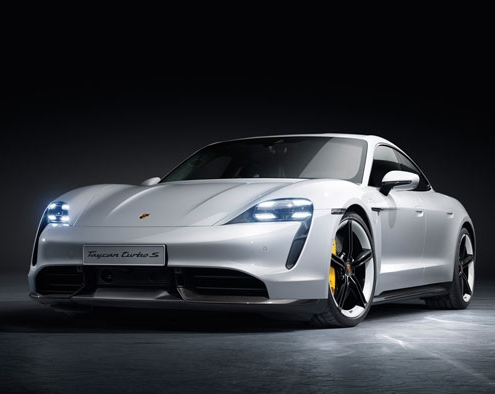Cover comes off the production Taycan
Porsche presented its first fully electric sports car, the Taycan, to the public with a world premiere held in September. The first models in the new series are the Taycan Turbo S and Taycan Turbo (even though, as electric cars, neither actually uses a turbocharger).
The flagship Turbo S version of the Taycan can generate up to 750hp (560 kW) of power in combination with Launch Control and overboost, while the Taycan Turbo can produce up to 670hp (500 kW). Porsche claims figures for the Turbo S will of 0-100km.h in around 2.6 seconds, while the Turbo can complete this sprint in around 3 seconds. The top track speed of both all-wheel-drive models is 260km/h.
The Taycan has a system voltage of 800 volts. Porsche says this means that, under ideal conditions, the charging time from five to 80 per cent State of Charge (SoC) is 22.5 minutes, with a maximum charging power (peak) of up to 270 kW. The overall capacity of the 800V high voltage battery is 93.4 kWh. Range for the models is reportedly 410km for the Turbo S and 450km for the Turbo.
There’s no doubt that the Taycan is a good-looking car, inside and out.
Porsche says the cockpit signals the start of a new era of interior design for the company with a new architecture. There’s a free-standing, curved instrument cluster with a 10.9-inch infotainment display at its centre. Combined with with an optional passenger display, this forms an integrated glass band in a black-panel look.
Control is ‘intelligent and intuitive’ using touch operation or a voice control function. Porsche offers an entirely leather-free interior option with the Taycan, with interiors made from recycled materials.
The Taycan Turbo S and Taycan Turbo have two electric motors, one on each axle, making the cars all-wheel drive.
There’s a two-speed transmission installed on the rear axle. First gear lets the Taycan prioritise acceleration from a standing start, while second gear, with its long gear ratio, ensures high efficiency and high-power reserves while traveling at high speeds.
The chassis system includes adaptive air suspension with three-chamber technology including PASM (Porsche Active Suspension Management) electronic damper control, as well as the optional Porsche Dynamic Chassis Control Sport (PDCC Sport) electromechanical roll stabilisation system including Porsche Torque Vectoring Plus (PTV Plus).
Multiple driving modes allow drivers to tailor their experience on the road. The four driving modes that are available include Normal, Sport, Sport Plus, and Range. In addition, individual systems can be configured as required in the ‘Individual’ mode.
11 Oct 2019
Original source: Motor Trader Magazine (Oct 2019)












